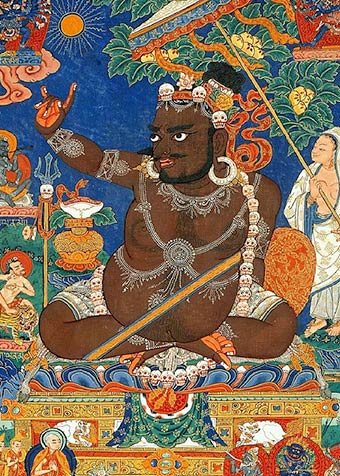Mahāsiddha Virūpa, the Lord of Yogins who lived in medieval India, received the Lamdré (Path and Its Result) instructions directly from the female buddha Vajra Nairātmyā, the consort of the tutelary deity Śrī Hevajra. He set forth these instructions in the Vajra Verses, which explicate the path to and result of perfect enlightenment, and the view of the inseparability of saṃsāra and nirvāṇa. He is thus considered the historical founder of the Lamdré, which after several generations was transmitted to the Sakya masters and became Sakya’s core system of teachings.
Born a Bengali prince, he renounced worldly life. He received ordination and the name Śrī Dharmapāla (Glorious Dharma Protector). While serving as the abbot of Nālandā University in India, he practiced and taught the common Buddhist teachings during the day; at night, he practiced the uncommon or esoteric Mantrayāna teachings that he had received from the prior abbot. But after many years, he became discouraged because he had no attainments and experienced illness and bad dreams. He threw his mala (prayer beads) in the latrine and gave up his esoteric practice. Vajra Nairātmyā, however, then appeared to him in the form of a blue lady. She explained that she was his karmic link deity, initiated him into the Śrī Hevajra maṇḍala, and bestowed instructions. He progressed rapidly along the bodhisattva bhūmis. He now recognized that his prior bad experiences were actually the clearing of obstacles and dawning of wisdom. In gratitude, he offered a ritual feast and engaged in behavior that caused controversy among Nālandā’s monks. He offered back his monastic robes and, wearing a cotton loincloth and taking on a wild appearance, became known as Virūpa or the ugly one.
Virūpa caused the Ganges river to reverse its flow and provide him a pathway, arousing faith in the Nālandā monks who doubted him. But he declined their request to return to Nālandā. Instead, he meditated and traveled throughout India, performing many miracles, arousing many people’s faith in the Triple Gem, and causing non-Buddhists to give up animal sacrifices and other non-virtuous practices. In one of his renowned displays of spiritual accomplishment, Virūpa caused the sun to stop moving across the sky for almost three days so that the tavern where he was drinking beer would have to stay open and keep serving him. His behavior, while sometimes unconventional and not to be imitated by ordinary individuals, demonstrated his transcendence of phenomena and dualistic views.
Virūpa’s two foremost disciples were Ḍombi Heruka, who was guided by instructions on the instantaneous path, and Kāṇha, who was guided by instructions on the gradual path. Virūpa’s Lamdré instructions were passed down from teacher to student for several generations in India. In the eleventh century, the Indian masters Viravajra and Gayādhara transmitted the instructions to the first Tibetan lineage holder Drokmi Lotsāwa. In turn, Drokmi taught Sakya monastery’s founder, Khön Könchok Gyalpo—establishing Sakya’s connection to Virūpa’s Lamdré teachings.

